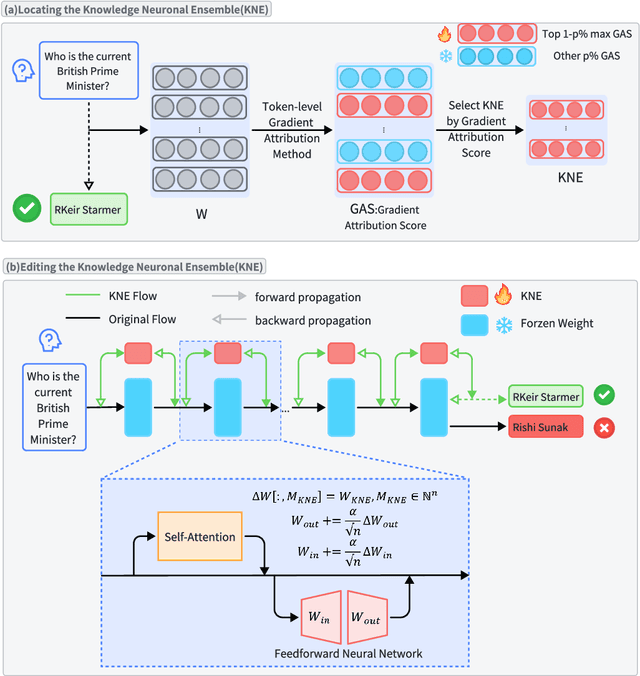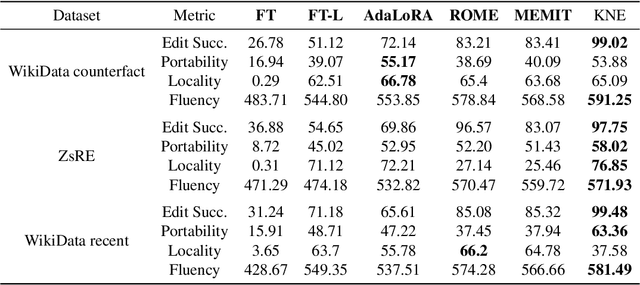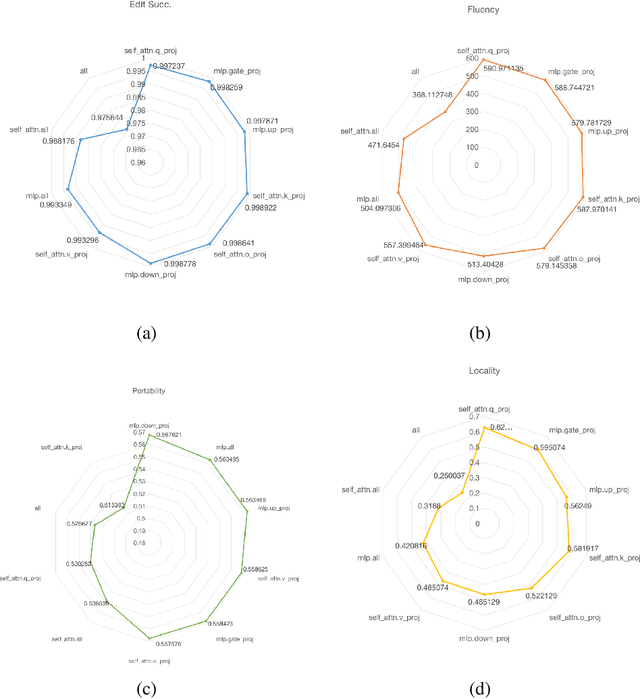Liang Xu
GLM-4.5: Agentic, Reasoning, and Coding (ARC) Foundation Models
Aug 08, 2025Abstract:We present GLM-4.5, an open-source Mixture-of-Experts (MoE) large language model with 355B total parameters and 32B activated parameters, featuring a hybrid reasoning method that supports both thinking and direct response modes. Through multi-stage training on 23T tokens and comprehensive post-training with expert model iteration and reinforcement learning, GLM-4.5 achieves strong performance across agentic, reasoning, and coding (ARC) tasks, scoring 70.1% on TAU-Bench, 91.0% on AIME 24, and 64.2% on SWE-bench Verified. With much fewer parameters than several competitors, GLM-4.5 ranks 3rd overall among all evaluated models and 2nd on agentic benchmarks. We release both GLM-4.5 (355B parameters) and a compact version, GLM-4.5-Air (106B parameters), to advance research in reasoning and agentic AI systems. Code, models, and more information are available at https://github.com/zai-org/GLM-4.5.
Perceiving and Acting in First-Person: A Dataset and Benchmark for Egocentric Human-Object-Human Interactions
Aug 06, 2025Abstract:Learning action models from real-world human-centric interaction datasets is important towards building general-purpose intelligent assistants with efficiency. However, most existing datasets only offer specialist interaction category and ignore that AI assistants perceive and act based on first-person acquisition. We urge that both the generalist interaction knowledge and egocentric modality are indispensable. In this paper, we embed the manual-assisted task into a vision-language-action framework, where the assistant provides services to the instructor following egocentric vision and commands. With our hybrid RGB-MoCap system, pairs of assistants and instructors engage with multiple objects and the scene following GPT-generated scripts. Under this setting, we accomplish InterVLA, the first large-scale human-object-human interaction dataset with 11.4 hours and 1.2M frames of multimodal data, spanning 2 egocentric and 5 exocentric videos, accurate human/object motions and verbal commands. Furthermore, we establish novel benchmarks on egocentric human motion estimation, interaction synthesis, and interaction prediction with comprehensive analysis. We believe that our InterVLA testbed and the benchmarks will foster future works on building AI agents in the physical world.
TeleOpBench: A Simulator-Centric Benchmark for Dual-Arm Dexterous Teleoperation
May 19, 2025Abstract:Teleoperation is a cornerstone of embodied-robot learning, and bimanual dexterous teleoperation in particular provides rich demonstrations that are difficult to obtain with fully autonomous systems. While recent studies have proposed diverse hardware pipelines-ranging from inertial motion-capture gloves to exoskeletons and vision-based interfaces-there is still no unified benchmark that enables fair, reproducible comparison of these systems. In this paper, we introduce TeleOpBench, a simulator-centric benchmark tailored to bimanual dexterous teleoperation. TeleOpBench contains 30 high-fidelity task environments that span pick-and-place, tool use, and collaborative manipulation, covering a broad spectrum of kinematic and force-interaction difficulty. Within this benchmark we implement four representative teleoperation modalities-(i) MoCap, (ii) VR device, (iii) arm-hand exoskeletons, and (iv) monocular vision tracking-and evaluate them with a common protocol and metric suite. To validate that performance in simulation is predictive of real-world behavior, we conduct mirrored experiments on a physical dual-arm platform equipped with two 6-DoF dexterous hands. Across 10 held-out tasks we observe a strong correlation between simulator and hardware performance, confirming the external validity of TeleOpBench. TeleOpBench establishes a common yardstick for teleoperation research and provides an extensible platform for future algorithmic and hardware innovation.
Intermediate Domain-guided Adaptation for Unsupervised Chorioallantoic Membrane Vessel Segmentation
Mar 06, 2025



Abstract:The chorioallantoic membrane (CAM) model is widely employed in angiogenesis research, and distribution of growing blood vessels is the key evaluation indicator. As a result, vessel segmentation is crucial for quantitative assessment based on topology and morphology. However, manual segmentation is extremely time-consuming, labor-intensive, and prone to inconsistency due to its subjective nature. Moreover, research on CAM vessel segmentation algorithms remains limited, and the lack of public datasets contributes to poor prediction performance. To address these challenges, we propose an innovative Intermediate Domain-guided Adaptation (IDA) method, which utilizes the similarity between CAM images and retinal images, along with existing public retinal datasets, to perform unsupervised training on CAM images. Specifically, we introduce a Multi-Resolution Asymmetric Translation (MRAT) strategy to generate intermediate images to promote image-level interaction. Then, an Intermediate Domain-guided Contrastive Learning (IDCL) module is developed to disentangle cross-domain feature representations. This method overcomes the limitations of existing unsupervised domain adaptation (UDA) approaches, which primarily concentrate on directly source-target alignment while neglecting intermediate domain information. Notably, we create the first CAM dataset to validate the proposed algorithm. Extensive experiments on this dataset show that our method outperforms compared approaches. Moreover, it achieves superior performance in UDA tasks across retinal datasets, highlighting its strong generalization capability. The CAM dataset and source codes are available at https://github.com/Light-47/IDA.
Label-free Prediction of Vascular Connectivity in Perfused Microvascular Networks in vitro
Feb 25, 2025Abstract:Continuous monitoring and in-situ assessment of microvascular connectivity have significant implications for culturing vascularized organoids and optimizing the therapeutic strategies. However, commonly used methods for vascular connectivity assessment heavily rely on fluorescent labels that may either raise biocompatibility concerns or interrupt the normal cell growth process. To address this issue, a Vessel Connectivity Network (VC-Net) was developed for label-free assessment of vascular connectivity. To validate the VC-Net, microvascular networks (MVNs) were cultured in vitro and their microscopic images were acquired at different culturing conditions as a training dataset. The VC-Net employs a Vessel Queue Contrastive Learning (VQCL) method and a class imbalance algorithm to address the issues of limited sample size, indistinctive class features and imbalanced class distribution in the dataset. The VC-Net successfully evaluated the vascular connectivity with no significant deviation from that by fluorescence imaging. In addition, the proposed VC-Net successfully differentiated the connectivity characteristics between normal and tumor-related MVNs. In comparison with those cultured in the regular microenvironment, the averaged connectivity of MVNs cultured in the tumor-related microenvironment decreased by 30.8%, whereas the non-connected area increased by 37.3%. This study provides a new avenue for label-free and continuous assessment of organoid or tumor vascularization in vitro.
BRIGHT-VO: Brightness-Guided Hybrid Transformer for Visual Odometry with Multi-modality Refinement Module
Jan 16, 2025



Abstract:Visual odometry (VO) plays a crucial role in autonomous driving, robotic navigation, and other related tasks by estimating the position and orientation of a camera based on visual input. Significant progress has been made in data-driven VO methods, particularly those leveraging deep learning techniques to extract image features and estimate camera poses. However, these methods often struggle in low-light conditions because of the reduced visibility of features and the increased difficulty of matching keypoints. To address this limitation, we introduce BrightVO, a novel VO model based on Transformer architecture, which not only performs front-end visual feature extraction, but also incorporates a multi-modality refinement module in the back-end that integrates Inertial Measurement Unit (IMU) data. Using pose graph optimization, this module iteratively refines pose estimates to reduce errors and improve both accuracy and robustness. Furthermore, we create a synthetic low-light dataset, KiC4R, which includes a variety of lighting conditions to facilitate the training and evaluation of VO frameworks in challenging environments. Experimental results demonstrate that BrightVO achieves state-of-the-art performance on both the KiC4R dataset and the KITTI benchmarks. Specifically, it provides an average improvement of 20% in pose estimation accuracy in normal outdoor environments and 259% in low-light conditions, outperforming existing methods. For widespread use and further development, the research work is fully open-source at https://github.com/Anastasiawd/BrightVO.
Knowledge Editing for Large Language Model with Knowledge Neuronal Ensemble
Dec 30, 2024



Abstract:As real-world knowledge is constantly evolving, ensuring the timeliness and accuracy of a model's knowledge is crucial. This has made knowledge editing in large language models increasingly important. However, existing knowledge editing methods face several challenges, including parameter localization coupling, imprecise localization, and a lack of dynamic interaction across layers. In this paper, we propose a novel knowledge editing method called Knowledge Neuronal Ensemble (KNE). A knowledge neuronal ensemble represents a group of neurons encoding specific knowledge, thus mitigating the issue of frequent parameter modification caused by coupling in parameter localization. The KNE method enhances the precision and accuracy of parameter localization by computing gradient attribution scores for each parameter at each layer. During the editing process, only the gradients and losses associated with the knowledge neuronal ensemble are computed, with error backpropagation performed accordingly, ensuring dynamic interaction and collaborative updates among parameters. Experimental results on three widely used knowledge editing datasets show that the KNE method significantly improves the accuracy of knowledge editing and achieves, or even exceeds, the performance of the best baseline methods in portability and locality metrics.
Distributed satellite information networks: Architecture, enabling technologies, and trends
Dec 17, 2024



Abstract:Driven by the vision of ubiquitous connectivity and wireless intelligence, the evolution of ultra-dense constellation-based satellite-integrated Internet is underway, now taking preliminary shape. Nevertheless, the entrenched institutional silos and limited, nonrenewable heterogeneous network resources leave current satellite systems struggling to accommodate the escalating demands of next-generation intelligent applications. In this context, the distributed satellite information networks (DSIN), exemplified by the cohesive clustered satellites system, have emerged as an innovative architecture, bridging information gaps across diverse satellite systems, such as communication, navigation, and remote sensing, and establishing a unified, open information network paradigm to support resilient space information services. This survey first provides a profound discussion about innovative network architectures of DSIN, encompassing distributed regenerative satellite network architecture, distributed satellite computing network architecture, and reconfigurable satellite formation flying, to enable flexible and scalable communication, computing and control. The DSIN faces challenges from network heterogeneity, unpredictable channel dynamics, sparse resources, and decentralized collaboration frameworks. To address these issues, a series of enabling technologies is identified, including channel modeling and estimation, cloud-native distributed MIMO cooperation, grant-free massive access, network routing, and the proper combination of all these diversity techniques. Furthermore, to heighten the overall resource efficiency, the cross-layer optimization techniques are further developed to meet upper-layer deterministic, adaptive and secure information services requirements. In addition, emerging research directions and new opportunities are highlighted on the way to achieving the DSIN vision.
Hyperparameter Tuning Through Pessimistic Bilevel Optimization
Dec 04, 2024



Abstract:Automated hyperparameter search in machine learning, especially for deep learning models, is typically formulated as a bilevel optimization problem, with hyperparameter values determined by the upper level and the model learning achieved by the lower-level problem. Most of the existing bilevel optimization solutions either assume the uniqueness of the optimal training model given hyperparameters or adopt an optimistic view when the non-uniqueness issue emerges. Potential model uncertainty may arise when training complex models with limited data, especially when the uniqueness assumption is violated. Thus, the suitability of the optimistic view underlying current bilevel hyperparameter optimization solutions is questionable. In this paper, we propose pessimistic bilevel hyperparameter optimization to assure appropriate outer-level hyperparameters to better generalize the inner-level learned models, by explicitly incorporating potential uncertainty of the inner-level solution set. To solve the resulting computationally challenging pessimistic bilevel optimization problem, we develop a novel relaxation-based approximation method. It derives pessimistic solutions with more robust prediction models. In our empirical studies of automated hyperparameter search for binary linear classifiers, pessimistic solutions have demonstrated better prediction performances than optimistic counterparts when we have limited training data or perturbed testing data, showing the necessity of considering pessimistic solutions besides existing optimistic ones.
Multi-scale Vehicle Localization In Heterogeneous Mobile Communication Networks
Dec 01, 2024Abstract:Low-latency and high-precision vehicle localization plays a significant role in enhancing traffic safety and improving traffic management for intelligent transportation. However, in complex road environments, the low latency and high precision requirements could not always be fulfilled due to the high complexity of localization computation. To tackle this issue, we propose a road-aware localization mechanism in heterogeneous networks (HetNet) of the mobile communication system, which enables real-time acquisition of vehicular position information, including the vehicular current road, segment within the road, and coordinates. By employing this multi-scale localization approach, the computational complexity can be greatly reduced while ensuring accurate positioning. Specifically, to reduce positioning search complexity and ensure positioning precision, roads are partitioned into low-dimensional segments with unequal lengths by the proposed singular point (SP) segmentation method. To reduce feature-matching complexity, distinctive salient features (SFs) are extracted sparsely representing roads and segments, which can eliminate redundant features while maximizing the feature information gain. The Cram\'er-Rao Lower Bound (CRLB) of vehicle positioning errors is derived to verify the positioning accuracy improvement brought from the segment partition and SF extraction. Additionally, through SF matching by integrating the inclusion and adjacency position relationships, a multi-scale vehicle localization (MSVL) algorithm is proposed to identify vehicular road signal patterns and determine the real-time segment and coordinates. Simulation results show that the proposed multi-scale localization mechanism can achieve lower latency and high precision compared to the benchmark schemes.
 Add to Chrome
Add to Chrome Add to Firefox
Add to Firefox Add to Edge
Add to Edge